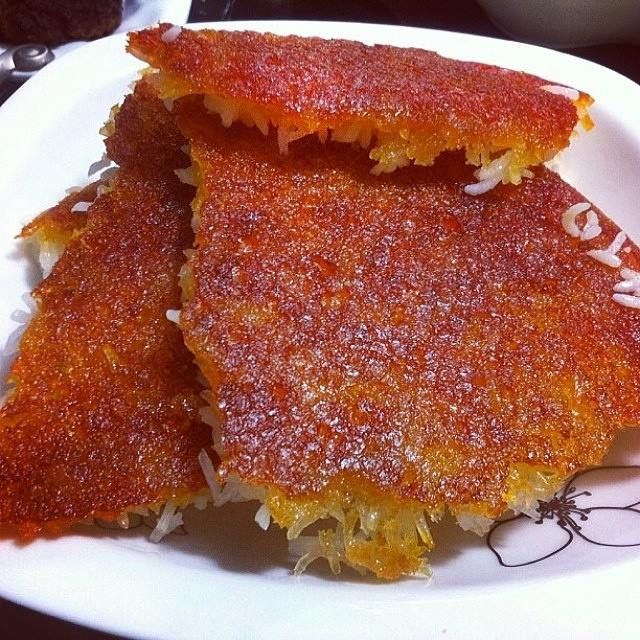Growing up in Iran, Google chef Hoss Zaré so coveted tahdig, the crisped layer of rice from the bottom of the pot, that he would make a game of hiding it in the kitchen. “I’d say, ‘It’s burned, you can’t have it,’” he confessed. “I was just trying to keep it from my brothers so I could have more.”
With a flavour that is part popcorn, part fried chicken, and the crunch of a thick potato chip, tahdig has been stirring covetous feelings stateside, too. Last year, in the final episode of the Netflix series “Salt, Fat, Acid, Heat,” Iranian American cookbook author Samin Nosrat cooked a beautiful iteration with her mother that made a case for the pleasure and drama of preparing it. On Instagram, one can browse endless documentation of rice inverted from the pot to display a golden-toasted crown—the sort of achievement a cook wants to broadcast.
Iranians often embellish tahdig’s lacquered layer with potato slices, lettuce leaves, sliced eggplant or onion rounds; sometimes they’ll swap in spaghetti for the rice. Chef Zaré, who for years helmed Zaré at Fly Trap restaurant in San Francisco, posts some of Instagram’s most awe-inspiring tahdig shots. He has a version that incorporates whole fish, a culinary hat-trick that results in crisp-skinned fish, fluffy rice and that crunchy layer of tahdig in one dish.
At the live-fire restaurant Maydan in Washington, D.C., it’s been served with clotted cream and caviar; at the Israeli restaurant Zahav in Philadelphia, tahdig comes topped with dried fruit and nuts. At Kismet in Los Angeles, it’s the best-selling dish. “A lot of people come for dinner just to taste the tahdig,” said co-chef and co-owner Sara Kramer. “It’s so universally lovable.”
There’s a certain suspense built in: You never know whether you’ve successfully pulled off that prized layer of gold until you flip over the pot and release the rice. Mr. Zaré, who now cooks at Google, enjoys teaching the young chefs he oversees to master it. “There’s a wow factor that you can see in their eyes,” he said. “When I demo tahdig, everyone has questions about how you do it.”
Iranian cooks hone their tahdig skills over a lifetime. Everyone else can turn to a slew of books, blogs and videos wherein tahdig masters share hard-earned secrets and turn their misfires into your future success. (See “The Golden Rules of Tahdig,” at left, for a solid primer.)
Naz Deravian, author of the cookbook “Bottom of the Pot,” sees herself as a sort of tahdig doctor. “I can look at pictures that people send me and figure out what went wrong,” she said. Azita Mehran, whose “Turmeric and Saffron” blog features traditional Iranian dishes, has a key piece of advice: “For Iranian cooking you really need to be focused, in tune and present.”
For Ms. Mehran, the passion tahdig inspires goes beyond the effort and attention required to make it. “It brings all the good memories back,” she said—of home, of growing up, of a country that no longer exists as it once did.
While tahdig is easy to love and anyone can master its making, Firoozeh Dumas, author of “Funny in Farsi: A Memoir of Growing Up Iranian in America,” noted the particular ferocity her Iranian family brings to their pursuit of that crisped rice. At first, her French husband, François, hung back on occasions when her relatives gathered for a meal as everyone else battled for the tahdig. Then her mother took pity. “Before anyone had a chance to take food, François would be handed his plate, with a large portion of tahdig already on it,” she said. That’s how much she loved him.

Saffron Rice Tahdig
Depending on the size of your skillet or pot, you may need more than 2 cups of rice to cover the bottom.
TOTAL TIME: 2½ hours SERVES: 4
2 cups basmati rice
Salt
1 teaspoon saffron threads
2 tablespoons warm water
3 tablespoons olive oil
1 tablespoon butter, broken in pieces, plus more to garnish
Dash of turmeric curcumin, optional
- Soak rice in salted cold water at least 1 hour or up to 24.
- Grind saffron, combine with warm water and let steep 15 minutes. Drain rice and rinse under cold water. In a stockpot, combine 8 cups water and 2 heaping tablespoons salt, and bring to a boil. Add rice and return to a boil, uncovered. After a few minutes, test a grain of rice by breaking it in half. The rice is ready when it’s still a little chewy and not fully cooked, like al dente pasta. Drain the rice and rinse under cold water to halt cooking. Set aside 2 cups parcooked rice.
- Heat a lidded deep 10” cast-iron skillet or Dutch oven over low heat 2 minutes, then add oil. Add two cups reserved rice, 1 teaspoon saffron water, turmeric if using, and ½ teaspoon salt. Stir to combine, then spread rice evenly over bottom of skillet, packing it down tightly with a spatula or wooden spoon.
- Heap remaining rice in center of skillet, coaxing it away from sides and shaping a dome. Poke holes in rice with the handle of a wooden spoon, avoiding packed layer on bottom. Drizzle remaining saffron water over rice. Scatter butter and ½ teaspoon salt on top. Cover tightly. Increase heat to medium and cook 7 minutes. Rice will sizzle and pop. Reduce heat to low and place a heat diffuser under skillet. Place a kitchen towel under lid and cover tightly. Cook 40 minutes.
- Fill sink with ice water 1 inch deep. Set skillet in ice water and let sit 2 minutes. Gently run a spatula under tahdig to loosen at edges. Place a kitchen towel on counter. Take a platter and place it on top of skillet. Wearing oven mitts, firmly hold skillet and platter together, and flip so platter is resting on dish towel. Carefully remove skillet.
- Show off the tahdig to your guests, then slide that layer onto a cutting board and gently slice it into pieces. Serve rice and tahdig on separate platters. Garnish rice with more butter.

Spaghetti and Meatballs Tahdig
It’s important that the pasta for this dish be cooked only until al dente when it goes into the skillet, otherwise it will become mushy.
TOTAL TIME: 2½ hours SERVES: 4
For the meatballs:
¼ cup basmati rice, soaked in water 1 hour
3 cloves garlic, chopped
2 tablespoons dried mint
½ onion, chopped
½ pound ground lamb, beef or mix
1 egg, whisked
2 teaspoons salt
1 teaspoon black pepper
3 tablespoons olive oil
For the spaghetti:
Pinch of saffron
2 tablespoons warm water
½ pound spaghetti
3 tablespoons olive oil, plus extra
2½ cups tomato sauce
½ cup grated Parmesan cheese, plus extra
Salt and pepper
Handful of parsley leaves
Chile flakes (optional)
- Make the meatballs: Strain rice and shake off excess water. In a food processor, combine rice with garlic, mint and onion, and pulse until coarsely ground. Transfer to a large bowl and add meat, egg, salt and pepper. Mix well. Form meat into approximately 20 heaping-tablespoon-size balls. Heat a large skillet over medium heat and add oil. Working in batches, cook meatballs until they’re well browned all over, about 10 minutes. Set aside.
- Grind saffron, combine with warm water and let steep 15 minutes. Meanwhile, fill a large pot with water and add a generous amount of salt. Cook pasta according to package instructions, stopping when pasta is just al dente. Strain under cold water to halt cooking and toss with a little olive oil. Set aside 2 cups plain pasta. Transfer remaining pasta back to pot along with tomato sauce, and toss over medium heat until heated through. Gently fold in meatballs and season everything to taste with salt and pepper.
- Make the spaghetti:Heat a deep, 10-inch cast iron skillet over medium heat. Once skillet is hot, add olive oil, then scatter plain pasta evenly over bottom. Sprinkle with a dash of salt, and drizzle with 1 teaspoon saffron water. Pour pasta and meatballs into skillet, coaxing them into the middle and away from the sides. Pour remaining saffron water over pasta. With the handle of a wooden spoon, poke holes into pasta mound, stopping short of bottom layer. Put a tight fitting lid over skillet and cook on medium heat 8 minutes. Pasta will sizzle loudly and oil will bubble up around the sides.
- Reduce heat to low and place a heat diffuser under skillet. Place a towel or damkoni under lid and cover skillet. Cook 30 minutes.
- Fill sink with ice water 1 inch deep. Place bottom of skillet in water to loosen tahdig. Gently run a spatula under tahdig to loosen at edges. Place a kitchen towel on counter. Take a platter and place it on top of skillet. Wearing oven mitts, firmly hold skillet and platter together, and flip so platter is resting on dishtowel. Carefully remove skillet.
- Finish tahdig with parsley, shaved cheese, salt and pepper, a drizzle of olive oil, and chile flakes, if using. Slide onto a cutting board and slice into quarters with a serrated knife.

Potato Tahdig with Herb Rice
TOTAL TIME: 2 hours SERVES: 4
2 cups white basmati rice, soaked in salted cold water for at least 1 hour
Large pinch of saffron
2 tablespoons warm water
1 scallion, sliced
2 cups fresh fava beans, shelled and peeled, or 2 cups frozen lima beans, thawed
1 cup grated multi-colored carrots
2 cups minced fresh herbs, any combination of dill, tarragon, parsley, cilantro, basil and mint
4 tablespoons olive oil
½ pound purple potatoes, peeled and sliced into rounds ¼-inch thick
Salt
1 tablespoon butter, broken in a few pieces, plus more to garnish
Edible flowers for garnish (optional)
- Drain rice and rinse under cold water. In a stockpot, combine 8 cups water and 2 heaping tablespoons salt, and bring to a boil. Add rice and return to a boil, uncovered. After a few minutes, test a grain of rice by breaking it in half. The rice is ready when it’s still a little chewy and not fully cooked, like al dente pasta. Drain rice and rinse under cold water to halt cooking. Set aside 1½ cups rice.
- Grind saffron, combine with warm water and let steep 15 minutes. In a large bowl, toss remaining rice with scallions, beans, carrots and herbs.
- Heat a deep 10” cast-iron skillet over low heat, then add oil. Cover bottom of skillet with a single layer of potato slices, leaving about ¼-inch of space between. Sprinkle with 1 teaspoon salt and drizzle with 1 teaspoon of saffron water. Scatter 1½ cups plain rice over top, pressing rice into crevices between potatoes with the back of a spoon.
- 4. Heap remaining rice in center of skillet, coaxing it away from sides and shaping a dome. Poke holes in rice with the handle of a wooden spoon, avoiding packed layer on bottom. Drizzle remaining saffron water over rice. Scatter butter and ½ teaspoon salt on top. Cover tightly. Increase heat to medium and cook 8 minutes. Potatoes and oil will sizzle loudly. Reduce heat to low and place a heat diffuser under skillet. Place a towel or damkoni under lid and cover tightly. Cook 40 minutes.
- Fill sink with ice water 1-inch deep. Set skillet in ice water and let sit 2 minutes. Gently run a spatula under tahdig to loosen at edges. Place a kitchen towel on counter. Take a platter and place it on top of skillet. Wearing oven mitts, firmly hold skillet and platter together, and flip so platter is resting on dishtowel. Carefully remove skillet.
- Show off the tahdig to your guests, then slide that layer onto a cutting board and gently slice it into pieces. Serve rice and tahdig on separate platters. Garnish rice with more butter and edible flowers, if using.
The Golden Rules of Tahdig
- Have everything at your fingertips. You will need to work fast.
- Stay within a moderate temperature range: medium/medium-low heat.
- Soak the rice in cold water for 1-24 hours before cooking to remove excess starch.
- Parcook the rice in salty water and finish by gently steaming.
- Put a towel under the pot lid to catch steam that rises as the rice cooks. Or use an Iranian damkoni, a fitted cloth.
- Use a heat diffuser, a metal disc that sits on the burner, to disperse heat.
- Dome the rice to give it room to expand and keep dried rice from sticking to the sides of the pot.
- Poke holes in the rice, without going as far down as the tahdig layer, to let steam escape.
- After cooking, loosen the tahdig by shocking the bottom of the pot in an inch of ice water for 2 minutes, or on a cool, damp towel for 5.Source: Wall Street Journal
